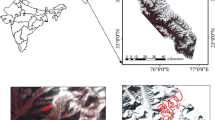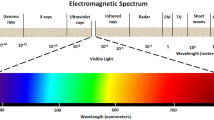Abstract
Snow is highly reflective in the visible region of the electromagnetic spectrum making it possible to easily distinguish on a satellite image. However, cloud cover and mountain shadows pose a serious problem in the identification of snow in a mountainous region. Therefore, to identify snow in such an environment, a Normalized Difference Snow Index (NDSI) has been applied. The NDSI is based on the high reflectance of snow in the visible region and its low reflectance in the SWIR region, whereas, reflectance of cloud remains high compared to snow in the SWIR region.
Efforts have been made to carry out field observations on reflectance of various land features near Manali in Himachal Pradesh (HP) to develop NDSI values for identifying snow. Field data have been collected using three field radiometers, viz., Multi-band Ground Truth Radiometer (GTR) operating in the 12 spectral bands ranging from visible to near-infrared wavelengths, Near-Infrared Ground Truth Radiometer (NIGTR) operating in the SWIR range, and Ratio-Radiometer (RR) operating in two spectral bands, one in the visible range, and another band in the SWIR range. All these three field radiometers have been designed and developed indigenously at the Space Applications Centre (ISRO), Ahmedabad. NDSI values for all types of snow, such as, fresh, clear, patchy and wet, have been found to be in the range 0.9 to 0.96. In addition, the NDSI value for snow under mountain shadow is found to be more than 0.9. This suggests the use of NDSI method for snow cover monitoring under mountain shadow. NDSI values for other land features such as soil, vegetation, and rock were substantially different than snow. However, water bodies have NDSI values close to snow and they need to be masked during snow cover delineation using NIR band.
Similar content being viewed by others
References
Bohren, CF. and Barkstrom, B.R. (1974). Theory of the optical properties of snow. J. Geophys. Res.0,79:4527–4535.
Bowker, D.E., Davis, R.E., Myrick, D.L., Stacy. K. and Jones, W.T. (1985). Spectral reflectances of natural targets for use in remote sensing studies. NASA RP-1139, 191p.
Canover, J.H. (1965).Cloud and terrestrial albedo determinations from Tiros satellite pictures. J. Applied Meteorology,4(3):378–386.
Dozier, J. (1985). Spectral signatures of snow in visible and near-IR wavelengths. Proc. 3rd International Colloquium on Spectral Signatures of Objects in Remote Sensing, Les Arcs, France, 16–20 Dec., 1985, ESA SP–247, pp. 437–442.
Dozier, J., Davis, R.E., Chang, A.T.C. and Brown. K. (1988). The spectral bi-directional reflectance of snow. Proc. 4th International Colloquium on Spectral Signatures of Objects in Remote
Sensing, Aussois, France, 18–22 Jan, 1988. ESA SP–287, pp. 87–92.
Hall, D.K., Riggs, G.A. and Salomonson, V.V.(1995). Development of methods for mapping global snow cover using Moderate Resolution Imaging Spectroradiometer data. Remote Sensing Env.,54:127–140.
Joseph George and Navalgund, R.R. (1991). Remote sensing-physical basis and its evolution. Glimpses of Science in India, National Academy of Sciences, Allahabad, India, 1991, pp. 357–385.
Manjul, S.S. and Pandya, R.M. (1983). Multi-band Ground Truth Radiometer manual. RSA/SDD/GS/02/12/83, Space Applications Centre, Ahmedabad.
Manjul, S.S. (2000). Technical datasheet on Near Infrared Ground Truth Radiometer. SAC/EOSG/SFSD/12/4/2000/10, Space Applications Centre, Ahmedabad.
Manjul, S.S. (2001). Design and development of Ratio Radiometer for snow and glacial studies. Technical Report: SAC/EOSG/FSD/27/4/2001/06, Space Applications Centre, Ahmedabad.
O’Brien, H.W. and Munis, R.H. (1975). Red and nearnfrared reflectance of snow. U.S. Army Cold Regions Research and Engineering Laboratory, Hanover, New Hampshire, CRREL Research Report 332, 18p.
Warren, S.G. and Wiscombe, W.J. (1980). A model for the spectral albedo of snow, II, Snow containing atmospheric aerosols. J. Atmospheric Sciences,37(12):2734–2745.
Wiscombe, W.J. and Warren, S.G. (1980). A model for the spectral albedo of snow, I, Pure snow. J. Atmospheric Sciences,37 (bd12):2712–2733.
Author information
Authors and Affiliations
About this article
Cite this article
Kulkarni, A.V., Srinivasulu, J., Manjul, S.S. et al. Field based spectral reflectance studies to develop NDSI method for snow cover monitoring. J Indian Soc Remote Sens 30, 73–80 (2002). https://doi.org/10.1007/BF02989978
Received:
Accepted:
Issue Date:
DOI: https://doi.org/10.1007/BF02989978




